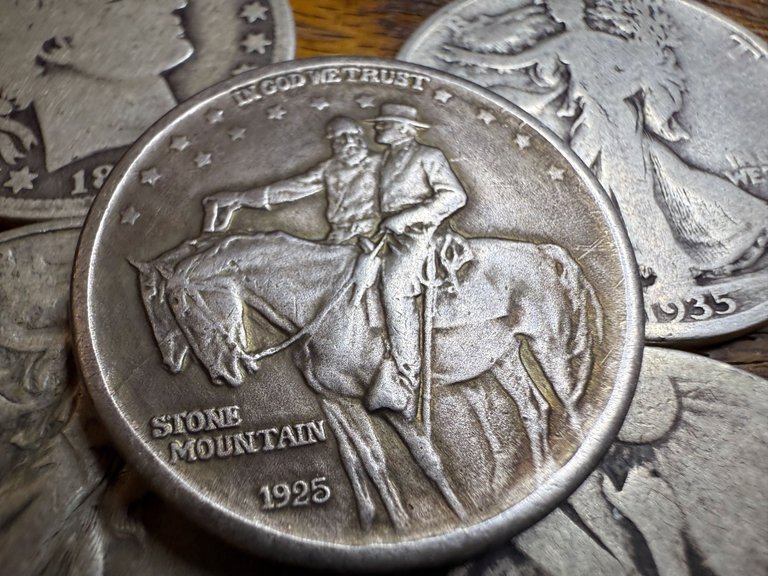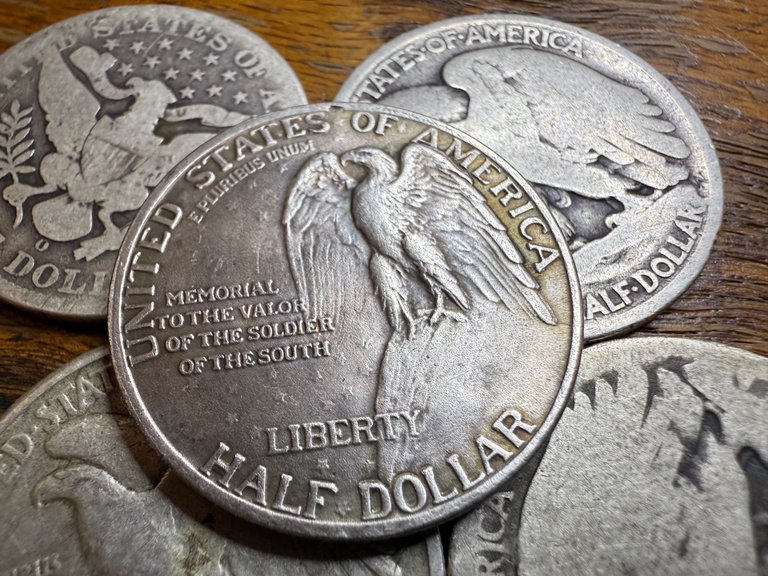This is a coin with a story, one that glimmers with silver but also casts a long shadow.
The 1925 Stone Mountain Memorial Half Dollar was part of an ambitious fundraising effort for a massive Confederate monument in Georgia. It’s a curious and conflicted piece of American history, struck not by the U.S. Mint for general circulation, but as a commemorative meant to finance a literal mountain carving. The idea was grand: raise money by selling a patriotic coin that glorified the Southern “Lost Cause”, then use the funds to carve Confederate generals into the side of a mountain. What could go wrong?
Let’s break it down.
Coin Details
- Year: 1925
- Metal: 90% silver, 10% copper
- Weight: 12.5 grams
- Designer: Gutzon Borglum (yes, the same man who later carved Mount Rushmore)
- Mintage: Around 1.3 million sold (of a planned 5 million)
The Coin
Before we get into the controversy, let’s look at the coin itself. It is a pretty good looking design. On the obverse we have Generals Robert E Lee and Stonewall Jackson on horseback.
 IMG_4875.jpeg
IMG_4875.jpeg
On the back, we have an eagle on a mountain with stars in the background and the words “Memorial to the valor of the soldier of the south”
 IMG_4877.jpeg
IMG_4877.jpeg
Here it is resting on a Peace dollar:
 IMG_4879.jpeg
IMG_4879.jpeg
Honor Thy Enemy
Well, we can see the problem. Generals Robert E. Lee and Stonewall Jackson were traitors to the US. Yet, they were being honored on a US coin? What gives? This would be like sticking Benedict Arnold on a coin — or over in the UK, sticking Guy Fawkes on a coin.
But there is a long history here, and it feeds into the Lost Cause pseudohistory promoted by the Daughters of the Confederacy — a movement that sought to rewrite the truth of the US Civil War, glorify slavery, create the narrative that African Americans were happier as slaves, change the cause of the war from slavery to State’s rights, paint the US as the aggressor, and basically flip the narrative to make the South the good guys and the North the bad guys. There’s too much history to get into here — and it’s still controversial depending on where in the US you happen to live — but just keep in mind that this influenced both the creation of the coin and what eventually led to its failure.
A Fundraising Flop
The coin was authorized by Congress in 1924 and minted in 1925, but sales never reached expectations. The marketing campaign targeted Southern pride, offering coins for $1 each—double face value. But internal squabbling, accusations of mismanagement, and public discomfort with the overt Confederate symbolism hurt the campaign.
Borglum, the original sculptor, was fired from the Stone Mountain project shortly after the coin was issued, and the carving itself wouldn’t be finished until decades later by another artist. In the meantime, many unsold coins were eventually melted down. Ironically, a coin meant to finance a grand, defiant monument ended up as a financial failure—yet became a fascinating collectible.
The Klan Connection
Yes, unfortunately, the Ku Klux Klan was involved. They supported the memorial and hoped to tie their white supremacist ideology to the monument—and by extension, the coin. This is one reason why the coin is viewed with discomfort today, despite its historical value and artistry.
If you’re a coin collector, this is one of those pieces that comes with baggage. It’s not just about silver weight or mintage rarity—it’s about what the coin was for. That can make it a conversation piece in your stack… or a reason to leave it out. Kind of like having Nazi coins — they’re historically significant, but they carry heavy baggage.
Value Today
You can still find Stone Mountain half dollars at coin shows and on eBay, usually priced between $40 and $100 depending on condition. They’re common enough that you won’t have trouble finding one, but rare enough in high grades that they command a premium. Coins with special markings (many were stamped with state initials as part of local fundraising campaigns) can fetch even more.
But do your homework. Many of these coins circulated poorly and have scratches, rim dings, or improper cleaning. Buying a graded one (NGC or PCGS) is safest if you’re particular about condition.
Why I Bought One
Well, why not, eh? It’s not often I get a chance to buy US coins over here, so I tend to take them when they come. It may be uncomfortable history, but it is history. You don’t have to approve of something to study it. And if we stop looking at uncomfortable history, we don’t learn from it.
Besides, it’s 90% silver, and old silver has a beauty and ring to it that modern rounds can’t match. The artistry is undeniable, and that’s part of what makes it such a complex object.

Do you have one of these in your stack? Would you ever want one? Does the historical baggage outweigh the value or interest? Or am I just exposing myself as a God-damned Yankee for suggesting there’s any controversy instead of simply admiring a beautiful coin? Let me know what you think.

